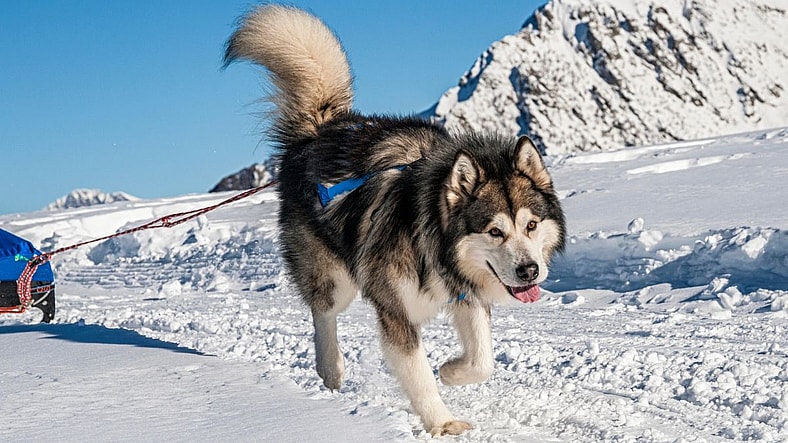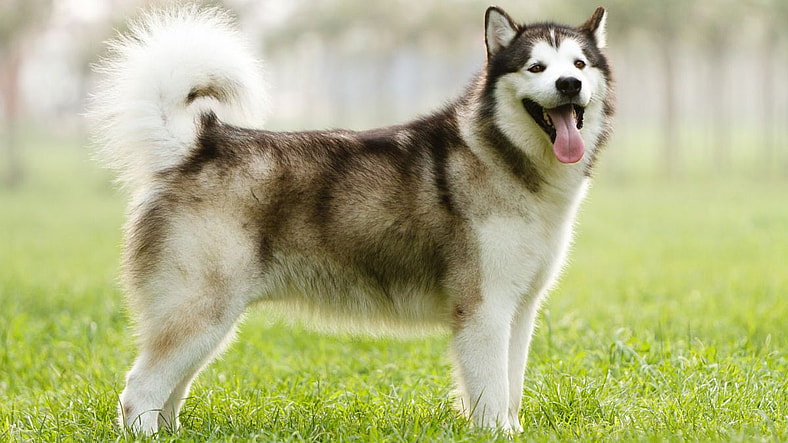The Alaskan Malamute: America’s Arctic Powerhouse and Alaska’s State Dog
When it comes to dog breeds with uniquely American roots, few are as iconic as the Alaskan Malamute—a powerful sled dog bred for survival in one of the country’s harshest landscapes. Not only is this Arctic giant beloved for its strength and spirit, but it’s also honored as the official state dog of Alaska, a title that speaks volumes about its heritage and importance.
From its origins with the Mahlemiut people to its place in homes and hearts today, the Alaskan Malamute is a living symbol of resilience, loyalty, and deep-rooted cultural connection.
🐾 A Breed Born in the Arctic

The Alaskan Malamute traces its origins to the indigenous Mahlemiut people, an Inuit tribe native to northwestern Alaska. These dogs weren’t bred for speed like modern racing huskies. Instead, they were the freight haulers of the Arctic—built for endurance and strength, capable of pulling heavy loads over long distances through snow and ice.
Early explorers and settlers in Alaska quickly recognized the value of these dogs, whose thick double coats, strong legs, and loyal temperaments made them ideal companions in the most unforgiving environments.
Today, they’re not just working dogs; they’re beloved pets in homes across the world. But their rugged beginnings remain central to their identity.
🇺🇸 A Symbol of the Last Frontier
There are many dog breeds with regional or national associations—Australian Shepherds, French Bulldogs, Tibetan Mastiffs—but surprisingly few are tied to specific U.S. locations. Unlike other breeds with regional ties—like the Australian Shepherd or French Bulldog—the Alaskan Malamute is the only American Kennel Club (AKC) breed that also holds the honor of being a U.S. state dog. Alaska officially recognized the Malamute as its state dog in 2010, a tribute to the animal’s historical and cultural significance in the region.

It’s not just a label. It’s a nod to the Alaskan wilderness that shaped this dog’s resilience, and to the culture of the Mahlemiut people who first nurtured the breed.
✨ Appearance & Coat
Malamutes are striking dogs with a wolf-like appearance and confident posture. They feature:
- A broad head, erect ears, and a thick, plume-like tail that curls over the back
- A dense, double-layered coat built for Arctic temperatures
- Color variations including light gray, black, red, and sable, always with white on the face, belly, legs, and tail underside
Be prepared for seasonal shedding, especially during spring and fall. Regular brushing several times a week is a must to keep their coat healthy and manage loose fur.
🧠 Temperament & Energy
Alaskan Malamutes are known for their loyalty, dignity, and strength—both physical and emotional. Here’s what to expect:
- Affectionate with family, including children
- Independent thinkers—they like to make their own decisions and require patient training
- Not big barkers, but they “talk” with expressive vocalizations and howls
- High stamina: they need daily activity, but aren’t hyper indoors
They do best with active, confident owners who can provide leadership and structure.

🧊 Built for Cold, Loved for Warmth
While their thick, insulating coats make them perfectly suited for colder climates, Alaskan Malamutes can adapt to a variety of environments as long as they receive proper care. They enjoy snow but will thrive in warmer areas too—with enough shade, water, and rest.
Training is key. Their intelligence and independent streak mean they respond best to firm, consistent guidance and early socialization.
📏 Quick Breed Facts
- Weight: 75–85 pounds (females), 85–100+ pounds (males)
- Height: 23–25 inches at the shoulder
- Coat: Dense, double-layered
- Temperament: Loyal, affectionate, independent, dignified
- Lifespan: 10–14 years
💡 Malamutes vs. Huskies: Not the Same!
| Trait | Alaskan Malamute | Siberian Husky |
|---|---|---|
| Size | Larger and heavier | Smaller and sleeker |
| Eyes | Usually brown | Often blue or multi-colored |
| Purpose | Freight pulling | Speed and racing |
| Temperament | Calm and powerful | Energetic and mischievous |
🛷 Still Used for Work—and Love
While few people today rely on dog sleds for transportation, Malamutes are still used in recreational mushing, skijoring, and weight-pulling competitions. Their power is no joke—some can pull over 1,000 pounds!
But more than anything, they’re loved as loyal companions. Their emotional intelligence and deep bonds with humans make them incredible family members. However, they’re not ideal for apartment living and need room to move.
🐕🦺 Rescue & Adoption Tips

Due to their size, energy, and shedding, Alaskan Malamutes sometimes end up in shelters when owners are unprepared for their needs. If you’re considering adopting one, do your research and connect with breed-specific rescue groups like:
Many wonderful Malamutes are waiting for second chances with families who understand them.
🌍 A Dog That Represents More Than a Place
The Alaskan Malamute isn’t just a breed—it’s a symbol of survival, strength, and the powerful bond between people and animals in some of the harshest climates on Earth. Named after the land that made them, these dogs are a living reminder of how history, environment, and companionship intertwine.
Whether you’re admiring their beauty from afar or snuggling with one on your couch, the Alaskan Malamute truly earns its title as America’s State-Named Sled Dog.
❓ Alaskan Malamute FAQ
Are Alaskan Malamutes good for first-time dog owners?
Not usually. Their size, strength, and independent streak make them best for experienced handlers.
Do Malamutes bark a lot?
Not typically. They’re more likely to howl or make “woo-woo” vocalizations.
Are Malamutes hypoallergenic?
No. They shed heavily and produce dander—definitely not ideal for allergy sufferers.
Do they get along with other pets?
It depends. Many Malamutes have a strong prey drive, so early socialization and supervision are crucial.
How much exercise do they need?
At least 1–2 hours daily of structured activity like hiking, pulling, or vigorous play.
Are they good with kids?
Yes! They’re generally gentle and affectionate, but supervision is important due to their strength.




